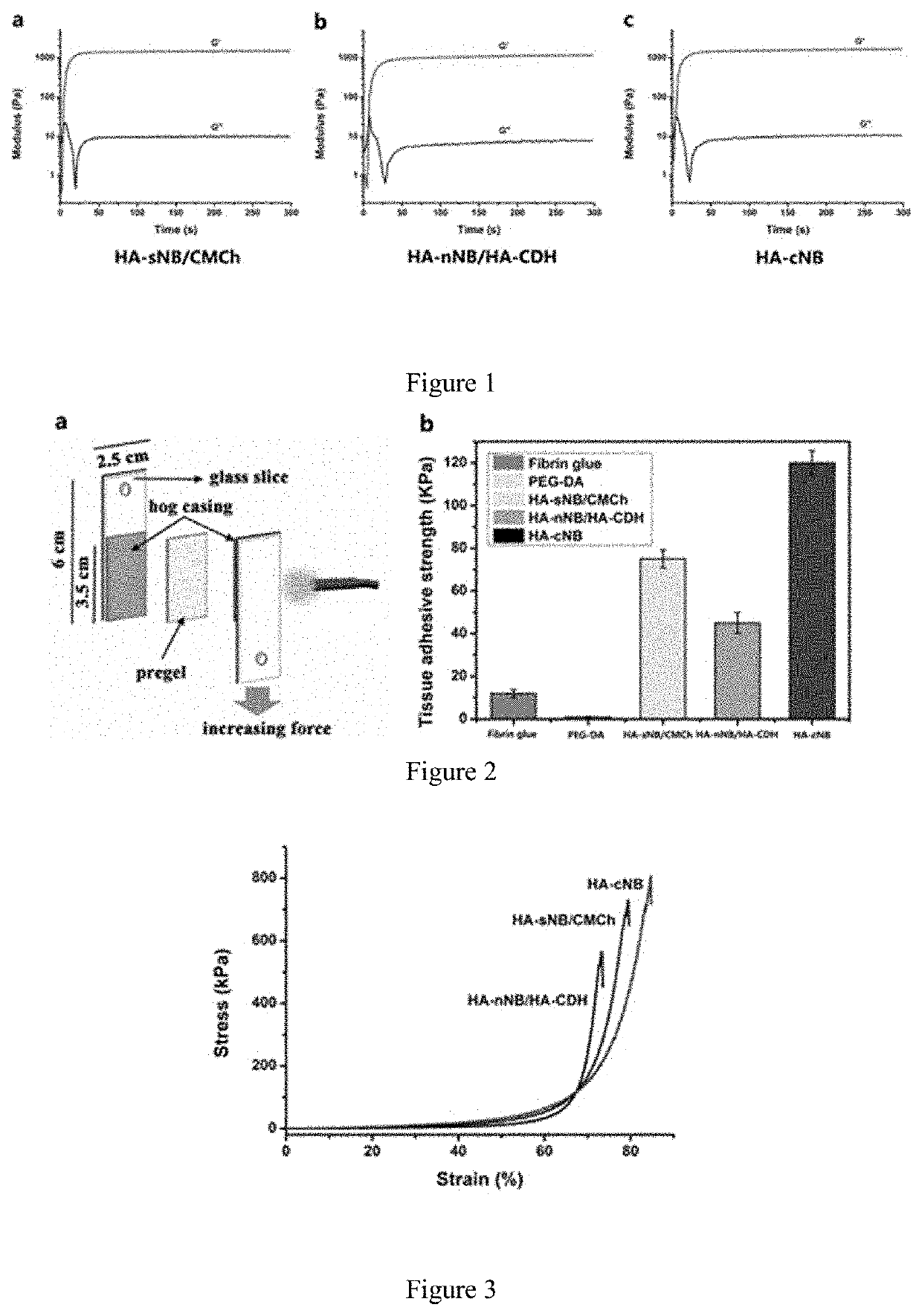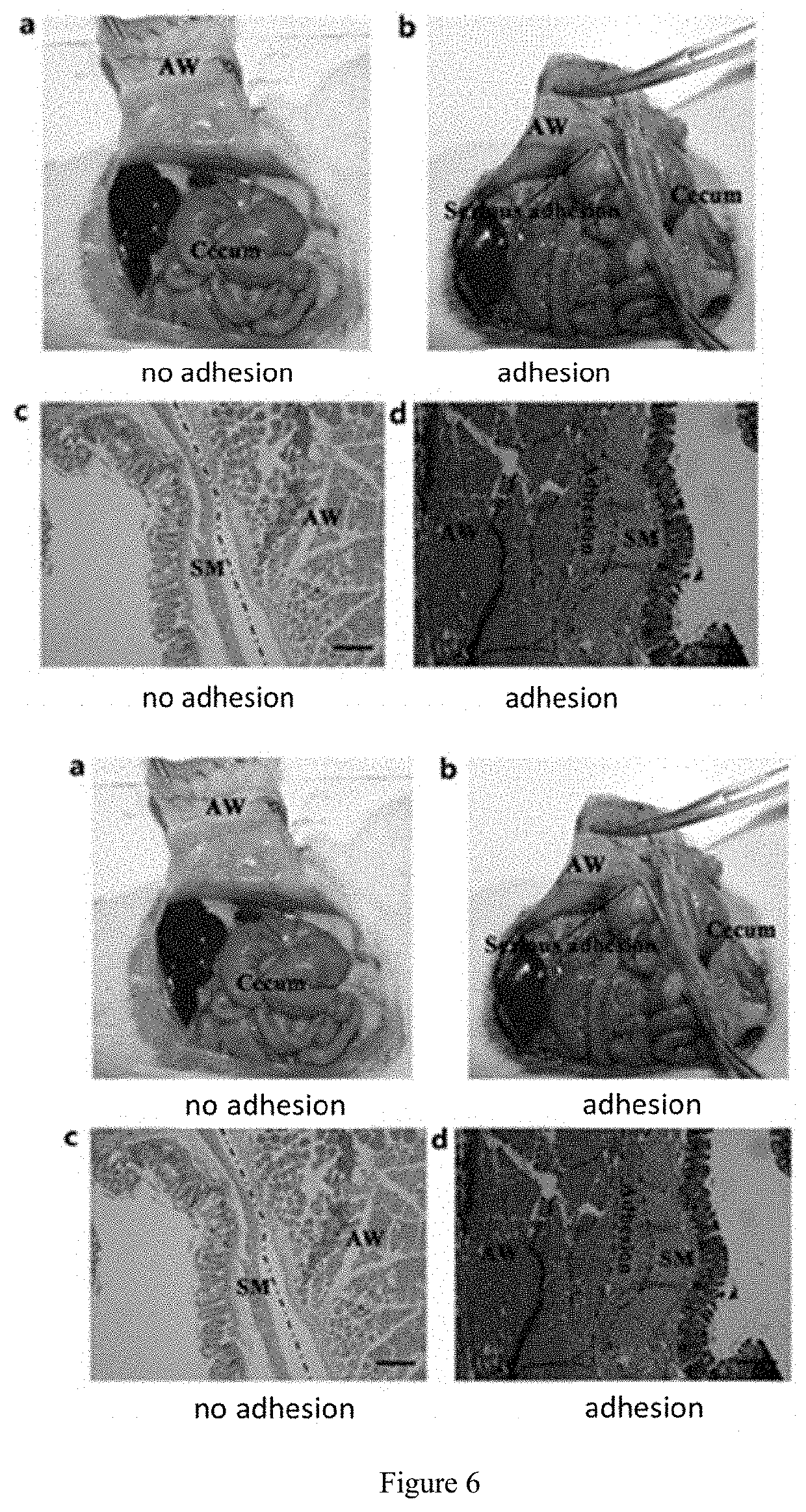Photo-coupled synergistically crosslinked hydrogel material and its composition, preparation method, use, product, and preparation kit
a photocoupled, synergistic technology, applied in the field of biochemical materials, can solve the problems of slow degradation in the body, weak gel strength, slow temperature response, etc., and achieve the effects of improving the mechanical properties, tissue adhesion, light curing speed and light curing speed of the hydrogel
- Summary
- Abstract
- Description
- Claims
- Application Information
AI Technical Summary
Benefits of technology
Problems solved by technology
Method used
Image
Examples
example 1
of Component A-1
[0226]
[0227](1) Synthesis of Compound 1: The synthesis was carried out in accordance with the method disclosed in the reference (Kunihiko Morihiro.; Tetsuya Kodama.; Shohei Mori.; Satoshi Obika. Org. Biomol. Chem. 2014, 12, 2468). 1H NMR (400 MHz, CDCl3): δ=7.71 (s, 1H), 7.22 (s, 1H), 4.03 (s, 2H), 4.13 (t, J=6.1 Hz, 2H), 3.99 (s, 3H), 3.32 (dd, J=11.6, 5.7 Hz, 2H), 2.82 (t, J=5.9 Hz, 2H), 2.44 (t, J=7.2 Hz, 2H), 2.26-2.17 (m, 2H). MS (ESI): [M+H] 344.1207.
[0228](2) Synthesis of Component A-1: To a solution of hyaluronic acid (2 g, 340 kDa) in 100 mL 0.01 mol / L 2-(N-morpholine) mesylate (MES) buffer solution (pH=5.2) was added Compound 1 (69 mg, 0.2 mmol) dissolved in 10 mL dimethyl sulfoxide (DMSO). 4-(4,6-Dimethoxytriazin-2-yl)-4-methylmorpholine hydrochloride (DMTMM, 0.4 g, 1.5 mmol) dissolved in 3 mL MES buffer was added to the above reaction solution by three times (every 1 h), and the mixture was reacted at 35° C. for 24 h. Then, the reaction solution was poure...
example 2
of Component A-2
[0229]
[0230](1) Synthesis of Compound 2: The synthesis was carried out in accordance with the method disclosed in the reference (Yunlong Yang; Jieyuan Zhang; Zhenzhen Liu; Qiuning Lin; Xiaolin Liu; Chunyan Bao; Yang Wang; Linyong Zhu. Adv. Mater. 2016, 28, 2724).
[0231](2) Synthesis of Compound 3: To a solution of Compound 2 (1 g, 3.0 mmol) in tetrahydrofuran (50 ml) was added carbon tetrabromide (CBr4) (2 g, 6.0 mmol) and triphenylphosphine (PPh3) (1.6 g, 6.0 mmol). The solution was stirred for 2 h at room temperature under the protection of Ar2. After completion of the reaction, the reaction was quenched by added water (5 ml), filtered and removed the solvent by rotary evaporation under reduced pressure and extracted with ethyl acetate, then purified by column chromatography (PE:DCM=4:1) to obtain Compound 3 (1.0 g, 84%). 1H NMR (400 MHz, CDCl3): δ=7.71 (s, 1H), 7.22 (s, 1H), 4.56 (s, 2H), 4.13 (t, J=6.1 Hz, 2H), 3.99 (s, 3H), 3.32 (dd, J=11.6, 5.7 Hz, 2H), 2.82 (t,...
example 3
of Component A-3
[0234]
[0235](1) Synthesis of Compound 5. The synthesis was carried out in accordance with the method disclosed in the reference (James F. Cameron.; Jean M. J. Frechet. J. Am. Chem. Soc. 1991, 113, 4303).
[0236](2) Synthesis of Compound 6. Compound 6 was obtained by the method of Example 2 using Compound 5 as raw material, the yield was 73%. 1H NMR (400 MHz, CDCl3): δ=7.71 (s, 1H), 7.22 (s, 1H), 4.66 (m, 1H), 4.13 (t, J=6.1 Hz, 2H), 3.99 (s, 3H), 3.32 (dd, J=11.6, 5.7 Hz, 2H), 2.82 (t, J=5.9 Hz, 2H), 2.44 (t, J=7.2 Hz, 2H), 2.26-2.17 (m, 2H), 1.33 (d, J=6.9 Hz, 3H). MS (ESI): [M+H] 404.0863.
[0237](3) Synthesis of Compound 7. Compound 7 was obtained by the method of Example 2 using Compound 6 as raw material, the yield was 70%. 1H NMR (400 MHz, CDCl3): δ=7.71 (s, 1H), 7.22 (s, 1H), 4.86 (m, 1H), 4.42 (m, 1H), 4.13 (t, J=6.1 Hz, 2H), 3.99 (s, 3H), 3.95 (s, 3H), 3.43 (d, J=5.6, 2H), 3.32 (dd, J=11.6, 5.7 Hz, 2H), 2.82 (t, J=5.9 Hz, 2H), 2.44 (t, J=7.2 Hz, 2H), 2.26-2.17 (...
PUM
| Property | Measurement | Unit |
|---|---|---|
| Fraction | aaaaa | aaaaa |
| Fraction | aaaaa | aaaaa |
| Fraction | aaaaa | aaaaa |
Abstract
Description
Claims
Application Information
 Login to View More
Login to View More - R&D
- Intellectual Property
- Life Sciences
- Materials
- Tech Scout
- Unparalleled Data Quality
- Higher Quality Content
- 60% Fewer Hallucinations
Browse by: Latest US Patents, China's latest patents, Technical Efficacy Thesaurus, Application Domain, Technology Topic, Popular Technical Reports.
© 2025 PatSnap. All rights reserved.Legal|Privacy policy|Modern Slavery Act Transparency Statement|Sitemap|About US| Contact US: help@patsnap.com



